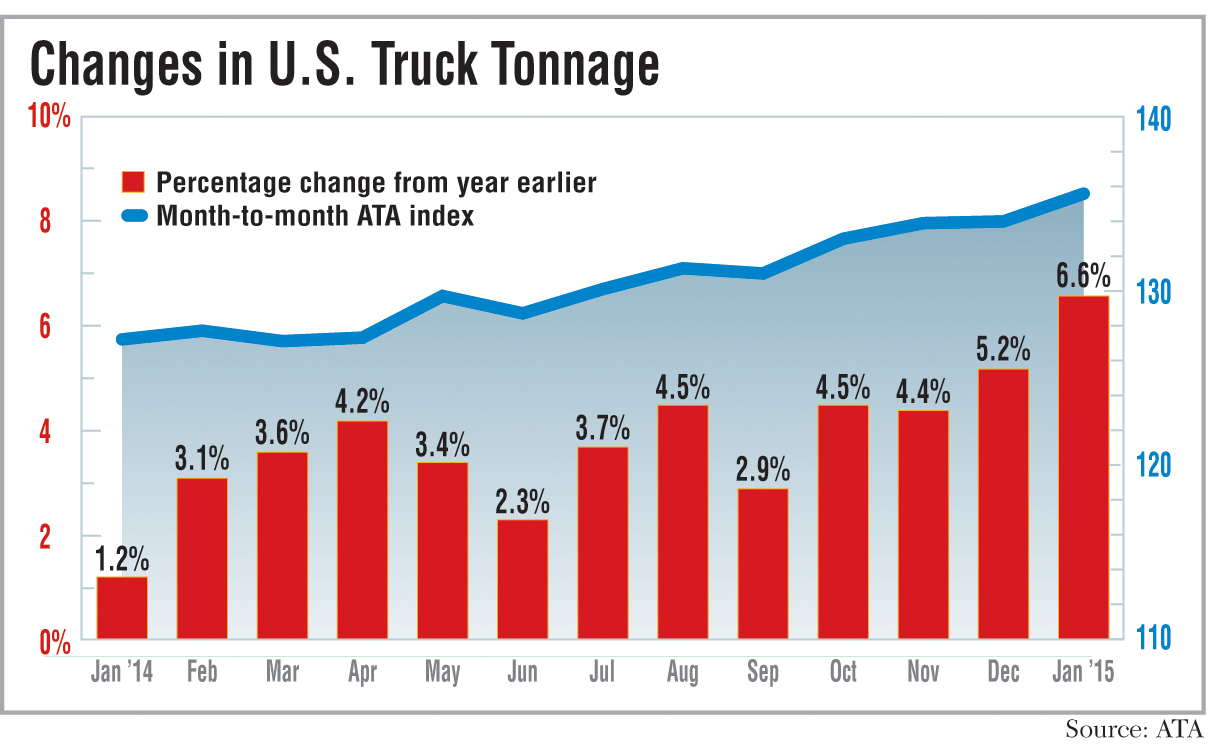Tonnage Index Rises 6.6%

This story appears in the March 2 print edition of Transport Topics.
Truck tonnage rose 6.6% in January from a year earlier to set another record, driven by a strong manufacturing sector and easier comparisons due to 2014’s weather-affected results, American Trucking Associations reported.
The preliminary seasonally adjusted index stood at 135.7 in January, an improvement of 1.2% from December. January’s year-over-year gain was the strongest since December 2013.
“Truck tonnage continued to improve in January, marking the fourth straight [sequential] gain,” said ATA Chief Economist Bob Costello.
The record-breaking streak began in October, and tonnage has increased a total of 3.5% on a sequential basis over that period, ATA reported. Its index of freight actually hauled rose 4% to 126.9 in January. On a sequential basis, it dropped 3.5%.
Factory output gained 6% on a year-over-year basis, almost keeping pace with tonnage growth, ATA said, including particular strength in the primary metals, electronics and apparel sectors.
Continued demand for steel used in auto production was a particularly strong factor in January, said Mark Montague, an analyst for load board operator DAT.
“Michigan, Illinois, Indiana, Alabama and Mississippi are the strong belt of manufacturing,” Montague told Transport Topics on Feb. 25.
Michigan-based Universal Truckload Services Inc. noted that strength at a recent presentation for investors.
The fleet projects vehicle sales of 17.3 million this year, helped by a stronger economy, lower oil prices and the favorable manufacturing environment.
The Commerce Department’s Feb. 26 report on durable goods orders underscored the manufacturing upswing, showing a 2.8% increase.
And despite record-breaking snow in parts of the Northeast this year, winter has been kinder.
“Weather was a factor making the year-over-year comparisons easier,” Costello said.
Last year’s weather-related supply chain disruption “depressed contract tonnage statistics and pushed extraordinary load volume into the spot market, where brokers and 3PLs tried to find capacity,” DAT Vice President Eileen Hart said.
Tonnage also was affected by January’s depressed West Coast freight activity, several sources said.
Montague described West Coast freight activity as “anemic.”
Costello said he believed the West Coast delays and congestion hurt volumes overall, though there was some moderating factor from cargo that was diverted to East Coast locations.
While West Coast port volumes suffered last month during extended dock slowdowns, there are widespread expectations of a freight surge as a cargo backlog is whittled down.
“We would expect to see an uptick in terms of overall freight activity during the month of March as the backlog moved from the West Coast and enters the supply chain,” Deutsche Bank analyst Robert Salmon told TT on Feb. 26.
Werner Enterprises President Derek Leathers was more succinct.
“It’s going to be a scramble,” Leathers said in a television interview last week. “Volume will be significantly higher than normal.”
Earlier in February, Leathers said Werner, which ranks No. 14 on the for-hire TT100, was having its best start in eight years in 2015.
Montague said fleets should be able to absorb the volume increase before typical seasonal spikes in produce shipments begin this spring.
As part of its revision process, ATA pegged tonnage growth for 2014 at 3.7%, compared with 3.4%.
“Last year was slightly better for truck tonnage than we originally thought, and I am expecting that momentum to continue in 2015,” Costello said.
He warned it will be difficult to sustain 6% higher factory output. He said he’s expecting a good year for factory production, but not a 6% gain, because the stronger dollar will hurt U.S. exporting.
Montague cited another weak spot, a drop-off in energy exploration tied to lower energy prices that particularly has hurt the Texas economy.
“Houston is very soft and flat,” he said, after years of strong freight levels tied to the gas and oil production increases.
Others also expressed caution.
“Things have started off more subdued,” Cleveland Research Co. executive Bryan Merolla said in a presentation last month. He spoke at a trucking conference sponsored by financial services firm Katz, Sapper & Miller.
“Shippers [are] having [a] much easier time covering loads through incumbent carrier-based network,” according to the presentation, citing potential reasons such as seasonality, more muted demand and better rail service.




